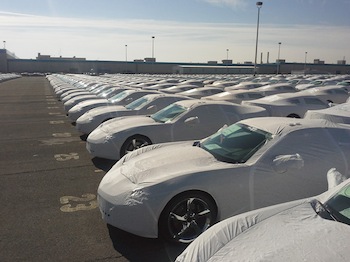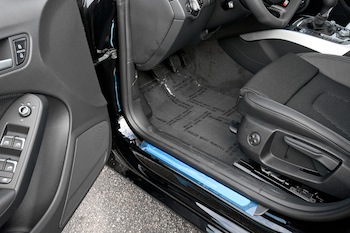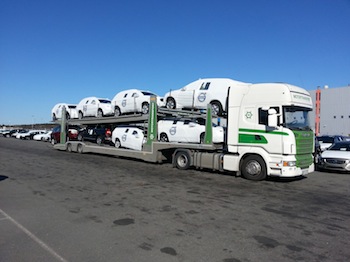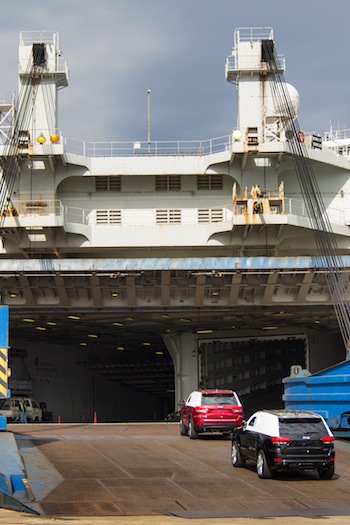With quality expectations higher than ever, OEMs have to consider the cost and general effectiveness of damage avoidance solutions, including full body covers.
 If there is one thing that carmakers, logistics providers, dealers and final customers can all agree on, it’s that a vehicle should arrive in the hands of customers without a scratch on it. However, many differ on what is the best way to avoid that damage. While most carmakers use some form of protective products, such as films, waxes or body covers, there are wide variations. At Daimler, for example, Jens Burmeister, manager of worldwide transportation operational quality, says the carmaker uses nano paint as a primary means of protection, which mostly eliminates the need for covers. However, he admits that while nano paint is good for protection against slight scratches, it does not work as well for acid rain and bird soil.
If there is one thing that carmakers, logistics providers, dealers and final customers can all agree on, it’s that a vehicle should arrive in the hands of customers without a scratch on it. However, many differ on what is the best way to avoid that damage. While most carmakers use some form of protective products, such as films, waxes or body covers, there are wide variations. At Daimler, for example, Jens Burmeister, manager of worldwide transportation operational quality, says the carmaker uses nano paint as a primary means of protection, which mostly eliminates the need for covers. However, he admits that while nano paint is good for protection against slight scratches, it does not work as well for acid rain and bird soil.
At Chrysler Group there is a general trend of targeting protection on specific areas of vehicles, but the carmaker is seeing a growing demand for added protection in international markets such as the Asia-Pacific region. According to Erika Mercado-Gratton, damage prevention and claims manager for outbound logistics, China has remarkably high expectations for vehicle protection.
Other carmakers use full body covers for different reasons in different destinations. Volvo Car Group, for example, has recently started applying them for shipments to Sweden in the winter and for exports to Russia all year round. Elsewhere, General Motors now fully covers all exports of its Corvette sports car as well as vehicles on a number of other shipping routes, according to international quality manager Noel Hunt.
The question for most carmakers is how best to balance the total cost of the product with the actual benefits of protection. Protective products can lower damage incidents, as well as reduce the need for special washing and other vehicle preparation. On the other hand, the use of full covers can require extra labour and costs that not every manufacturer believes are worthwhile. Some companies point to disadvantages in using excessive coverage, such as hidden damage. Another issue is how long a cover should be used once applied. In cases where brand promotion is an objective, such costs might be offset.
Connell Clarke, account executive at claims management company Sevatas says OEMs must consider branding, storage, transport mode and routes as well as the risk of airborne damage prevention.
The use of different forms of vehicle protection is also dependent upon the receiving market’s perception of risk in transport. In some regions there is a strong preference for full covers, particularly in areas prone to extreme weather. Also certain transport modes and methods tend to invite different protection. Sevatas performs analyses at European exit ports, where Clarke says premium brands such as Bentley ship in containers to Brazil with standard protection, including films, while vehicles moved by ro-ro to the US or Asia use full body covers. Within Europe, less protection is used.
Captured in film
One of the most common methods of protection is the use of films and wrap guard. France-based company Novacel offers self-adhesive films called Novaguard that may remain in place for several months. John Austin, business development manager at Novacel, explains that Novaguard is water-based as opposed to solvent-based and peels easily compared to some other wrap guards. Its primary customers are the Detroit three, including General Motors’ use of the products for exports. Michele Naulot-Besson, business unit director for the automotive market at Novacel, says among the products is a wheel film, which is a transparent laminate on a paper liner, that was taken up by a major American carmaker in mid-2013.
At TM Claims Service, which works specifically with Japanese carmakers, Dmitry Volodinsky, manager for the marine claims division, says the level of wrap guard protection varies depending on location. Mexico, which has low labour costs, applies a high level compared to Japan, where labour is more expensive. American-produced Japanese vehicles have a level of protection somewhere in the middle.
Volodinsky says that the trend is to move away from wrap guard because of its cost and the difficulty in quantifying its benefits. “The problem is that for an extended period, beyond six or seven days, vehicles could sustain damage without protection,” he explains.

Another company that works with wrap guard as well as other protective materials is logistics provider Gefco, which handles finished vehicle distribution worldwide, including in the Asia-Pacific region. In China, Gefco serves Capsa, a joint venture between the Changan Automobile Group and the PSA Group, based in Shenzhen, which produces the DS5 model. “The DS5 has a low and wide chassis, which makes it challenging to load in Chinese trailers. The wide range of trailers in China has added to the challenge,” explains Christophe Poitrineau, president of Gefco Asia.
Poitrineau points out that most Chinese trailers have higher loading angles, shorter ramps, and are narrower than their European counterparts. Due to the DS5’s particular chassis, Gefco uses a combination of wrap guard and foam for the front bumper to protect against deep scratches, since vessel ramps can be quite steep. It also uses foam protection for the door handles combined with plastic shock absorbers on the door panel. Currently, most of the imports that Gefco handles to China have partial body covers from boot to bonnet to protect the chassis.
By contrast, there have been some moves away from protective wax, such as at Geely International Corporation, the export arm of China’s Geely. “Two years ago, we used ocean waxes in order to prevent rust. In doing so, we found that particles were sticking to the wax and turning the vehicles black,” says logistics supervisor Prince Chen. “This made it difficult to detect scratches and dents, and we incurred extra washing charges, so we stopped using it. The result has been a reduction in costs and lead time.”
Choosing the right protection
For Gefco, vehicle protection requires assessment of each vehicle type and mode of transport, as well as proper training for drivers. “Our objective is to apply the most accurate level of protection. One challenge is that the type of protection should factor in both the model design and the shipment itinerary,” says Poitrineau. For locally produced vehicles, Gefco considers what transport resources are available locally and what poses a moderate or serious threat to ensure safe transport. The other consideration is the actual shape and height of the chassis.
“Typically, protection should include reinforced bumpers and shock absorbers on the external door panels, and roof covers in case of rail transportation,” says Poitrineau.

At Sevatas, Clarke says it is important to apply protective materials in a timely manner at the end of the production line to avoid protection such as door pads being applied in the wrong position due to “improper training or apathy”.
Another issue is whether protection is cost effective for small volumes. In the past, a manufacturer would protect all of its vehicles, but according to Clarke, it is better to be proactive by route, transport mode, maturity of the market and risk. Since new models are longer and wider, and manufacturers still need to maximise their loads and revenue, vehicle dimensions could influence the type of protection used, such as in the case of wheel protection, he adds.
Opting for full coverage
There are signs that the trend in protection is swinging towards full body covers, at least on some export lanes. Andreas Bottcher, managing director at Sweden-based Trox Cover, says the full body cover market is now in the region of 2m-3m units per year.
Giovanni Garzone, business development manager at Italian coverings provider Confezioni Andrea, says customers that were already using fully body covers are increasing their usage by at least 30%. The company supplies about 1.5m full body covers and partial covers worldwide to prevent damage and save on costs such as washing, cleaning, polishing and inspection. Its customers include Volkswagen, Audi, Porsche, Fiat, Renault, GM and Jaguar Land Rover.
Garzone says the use of its full covers can reduce damage by typically more than 90% compared to not using a cover; those applied by two people take an average of three-and-a-half minutes for regular-sized vehicles and five minutes for big cars, SUVs and pickups.
At GM’s plant in Bowling Green, Kentucky, the OEM began using full body covers in June 2013 for all of its Corvette exports. Garzone says the carmaker uses about 26,000 full body covers – half for Corvettes and half for pickups. It also uses about 10,000 partial body covers. He adds that OEMs are realising the cost savings and improved quality made possible by full body covers, including the need for less hard reconditioning work at dealerships.
Novacel’s Austin agrees there is more growth in protective sprays or full body covers than films. “The trend is moving away from film to robotic sprayable protection or full body covers due to labour costs,” he admits. [sam_ad id=6 codes='true']
Some carmakers are looking for more robust material, such as full covers that are made of plastic on top and fabric underneath. For example, Volkswagen uses this type of cover on its bonnets and roofs. “Volkswagen is evolving as it has been releasing new models over the past couple of years,” says Sevatas’s Clarke. “This is standard across the company, which is an element of its purchasing power. Maximising protection is a priority since many vehicles move on rail within Europe, which has its own particular challenges such as rail dust.”
This past January, Volvo Car Group began an initial phase of using full body covers in Sweden and Russia. According to Riitta Honkanen, manager of damage prevention and outbound audits for outbound logistics, the aim is to protect vehicles from dirt and scratches caused by winter and road conditions as they move long distances on open trailers. “Initially, we will use full body covers in Sweden for the winter and the autumn. Russia will be throughout the year, and we will do the same in Sweden beginning next year,” she says.
"We are using [full body] covers in Russia, but due to our reduction in plant hours per vehicle – the goal for which is 30 – the additional five to ten minutes needed to apply the cover could be an issue" - Jens Burmeister, Daimler
Daniel Karjalainen, product manager, research development, surface treatment engineering at the carmaker, says Volvo began its rollout in Sweden because it is easier to track results in its home country. Norway and Finland were also part of the pilot programme. “We are rolling it out in different phases and defining standards so we have a good quality launch,” he says. “The next phase is to meet market demand as well as possible. We need to dig into the distribution flow to assess the risks and decide on the next steps.”
Honkanen adds that with full body covers, Volvo needs to look more to the total value chain from car design to dealership. Thus far, it has found significant damage reduction with full body covers.
Trox Cover provides a recyclable, polypropylene and polyester plastic film laminate full body cover to Volvo Cars, Daimler, BMW, and the Volkswagen Group. It also offers partial (half) body covers for bonnets and roofs. Full body cover takes four to six minutes for two people to apply, according to managing director Andreas Bottcher. “Our product is used for all transport modes, including ocean which it protects against salt. Volkswagen uses it for most of its deep sea shipments,” he says. Trox covers can also be supplied adorned with the carmaker’s logo.
Jens Burmeister says Daimler’s customers in Russia and Israel have requested full body covers. “Israel has asked us for 2,000 units, but we have not decided yet. In Russia, we use about 50,000 units,” he says. Daimler began to use the covers in April 2013 for almost every model that it ships to Russia except for small volume shipments. It uses Trox Covers in Russia to protect against the rough weather and poor road conditions.
“We are using the covers in Russia, but due to our reduction in plant hours per vehicle – the goal for which is 30 – the additional five to ten minutes needed to apply the cover could be an issue,” he admits. “The second reason is that other countries would ask for it whether they need it or not.”
Burmeister says the decision over whether to fit the full body covers at the plant or at the port will be taken during the first half of this year. He reports that Daimler has experienced about 60% damage reduction in Russia during summer and autumn of 2013 compared to the same period in 2012. The full body cover reduced small scratches from stones as well as fallout from the air. There was an issue in Russia with small chip damage on winter roads where sand and gravel are used for traction. One disadvantage is that the cover does not go over the wheel rim, which leaves it exposed to gravel or damage from mishandling. “We also cannot have too rigid of a wheel cover or it could fly off. In fact, we have no solution yet,” admits Burmeister.
A targeted approach
Chrysler’s approach to vehicle protection has been to focus on target areas that are more susceptible to damage, such as front and rear fascias, as well as driver’s door edges. In the latter area, it is currently switching from a foam block to plastic strips. “The door edge strip has contributed to the complete elimination of door edge damage,” notes Erika Mercado-Gratton.
"Our goal is to increase the usage of fascia protection throughout the supply chain – not only in shipping vehicles to our dealers, but also in shipping the fascia from the supplier to our assembly plants" - Erika Mercado-Gratton, Chrysler
She points out that although Chrysler has used full body covers in unique scenarios, it tries to avoid them for regular shipping as they can conceal damage. “Overall, we have
 Chrysler has increased the targeted protection of vehicles in an effort to ensure the methods it uses are the most effective and durable in each instance
Chrysler has increased the targeted protection of vehicles in an effort to ensure the methods it uses are the most effective and durable in each instanceseen higher demand for the use of full body covers, especially for vehicles destined to international markets, as well as the use of containers as an alternative for vehicle protection. However, we have found that covering the entire vehicle or containerising it with space constraints is not usually the best option,” she says.
Chrysler has increased the use of protection on targeted areas of its vehicles as part of an overall effort to increase damage awareness in the supply chain. “For example, we have learned that using film on specific areas of the fascia can prevent about 30% of claims related to low severity scratches,” says Mercado-Gratton. “Therefore, our goal is to increase the usage of fascia protection throughout the supply chain – not only in shipping vehicles to our dealers, but also in shipping the fascia from the supplier to our assembly plants.”
For fascias produced at Chrysler’s Brampton, Ontario plant, which builds the 300, Charger, and Challenger models, the carmaker achieved a 75% reduction in damage in 2013.
Chrysler has also successfully rolled out specific initiatives for local dealers and for international markets, such as providing more protection on chrome parts and emblems that are exposed to salt water and are susceptible to rust while the units are at the ports. For the carmaker, the biggest challenge is to ensure that the protection will actually prevent certain types of damage. “This is the main reason why we are reluctant to use full body covers across the board,” explains Mercado-Gratton.
Another challenge is to ensure that the protective material is sturdy enough to stay on the vehicle throughout the distribution network. She adds that from a financial standpoint, the biggest challenge is to show that being proactive and investing in protective material actually results in overall savings to Chrysler, improved customer perception, and shorter delivery times.
As a means of fostering a consistent approach, Chrysler is developing common protection among all of its platforms and brands, including for Fiat products. It has also increased the quality of its washing procedures for units destined to Australia in compliance with the country’s environmental standards. “With special washing procedures, we have decreased by half the number of vehicles with native North American seeds, in order to minimise any risks to Australia’s environment,” says Mercado-Gratton.
The targeted approach to protection is reflected at Volvo Car Group, which uses white plastic film on various exterior surfaces. At the beginning of model launches the film is also used on roofs until dealerships become more comfortable without it, according to Riitta Honkanen.
Geely International uses film wraps, waxes, foam blocks for doors and full body covers only for lengthy storage, says Prince Chen. The carmaker is also looking to protect the driver’s area in the interior, including the doorsill, floor, door panel, shift area and even the rear seats. Cardboard is used in the foot wells and centre consoles.
For its inter-regional ocean shipments, General Motors also protects the interior driver’s side and uses film or full body covers for the exterior, according to Hunt.
Whereas the methods of vehicle protection vary based on a number of factors, the primary goal is always the same: to minimise damage as cost-effectively as possible. Carmakers evaluate their needs on an ongoing basis, but depending on their different destination markets and the size and requirements of their products, many are likely to keep coming up with different conclusions.

























![Global[1]](https://d3n5uof8vony13.cloudfront.net/Pictures/web/a/d/s/global1_726550.svgz)









